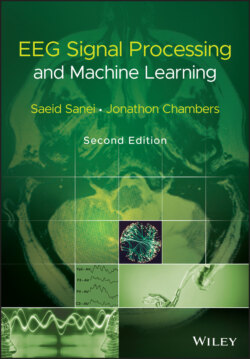Читать книгу EEG Signal Processing and Machine Learning - Saeid Sanei - Страница 47
3.4.1 Linear Models 3.4.1.1 Prediction Method
ОглавлениеThe main objective of using prediction methods is to find a set of model parameters which best describe the signal generation system. Such models generally require a noise type input. In autoregressive (AR) modelling of signals each sample of a single channel EEG measurement is defined to be linearly related with respect to a number of its previous samples, i.e.:
(3.40)
where ak , k = 1,2,…,p, are the linear parameters, n denotes the discrete sample time normalized to unity, p is called the model or prediction order and x(n) is the noise input. In an autoregressive moving average (ARMA) linear predictive model each sample is obtained based on a number of its previous input and output sample values, i.e.:
(3.41)
where bk , k = 1, 2,…, q are the additional linear parameters. The parameters p and q are the model orders. The Akaike criterion can be used to determine the order of the appropriate model of a measurement signal by maximizing the log-likelihood equation [22] with respect to the model order:
(3.42)
where p and q represent respectively, the assumed AR and MA model prediction orders, N is the number of signal samples, and is the noise power of the ARMA model at the pth and qth stage. Later in this chapter we will see how the model parameters are estimated either directly or by employing some iterative optimization techniques.
In a multivariate AR (MVAR) approach a multichannel scheme is considered. Therefore, each signal sample is defined versus both its previous samples and the previous samples of the signals from other channels, i.e. for channel i we have:
(3.43)
where m represents the number of channels and xi (n) represents the noise input to channel i. Similarly, the model parameters can be calculated iteratively in order to minimize the error between the actual and predicted values [23].
Figure 3.12 A linear model for the generation of EEG signals.
There are numerous applications for linear models. These applications are discussed in other chapters of this book. Different algorithms have been developed to find efficiently the model coefficients. In the maximum likelihood estimation (MLE) method [23–25] the likelihood function is maximized over the system parameters formulated from the assumed real, Gaussian distributed, and sufficiently long input signals of approximately 10–20 seconds (consider a sampling frequency of fs = 250 Hz as often used for EEG recordings). Using Akaike's method the gradient of the squared error is minimized using the Newton–Raphson approach applied to the resultant nonlinear equations [23, 26]. This is considered as an approximation to the MLE approach. In the Durbin method [27] the Yule–Walker equations, which relate the model coefficients to the autocorrelation of the signals, are iteratively solved. The approach and the results are equivalent to those using a least‐squared‐based scheme [28]. The MVAR coefficients are often calculated using the Levinson–Wiggins–Robinson (LWR) algorithm [29]. The MVAR model and its application in representation of what is called a direct transfer function (DTF), and its use in quantification of signal propagation within the brain, will be explained in detail in Chapter 8 of this book. After the parameters are estimated the synthesis filter can be excited with wide sense stationary noise to generate the EEG signal samples. Figure 3.12 illustrates the simplified system.
The prediction models can be easily extended to multichannel data. This leads to estimation of matrices of prediction coefficients. These parameters stem from both the temporal and interchannel correlations.
